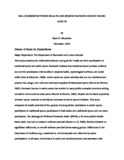Relationship Between Health And Sports Participation in Young Adults
Author
Moynahan, Ryan D.
Abstract
This study examines the relationship between young adults' health and their participation in traditional sports and action sports. Research indicates that traditional sports promote wellness and provide participants with benefits in physical health, psychological wellness, and social skills (Taks & Scheerder, 2006). Action sports are sports activities that are non-traditional and possess risk, danger, and rules and techniques atypical of mainstream sports (Bennet & Henson, 2003). Increased interest in action sports has resulted in many public recreation providers adding recreation venues such as skate parks (Bennet & Henson, 2003). Despite the increased popularity of action sports, research to identify the outcomes of action sports is limited. This study compared the health potential of four groups of young adults: participants in action sports, participants in traditional sports, participants in both action and traditional sports, and non-sport participants. The Salutogenic Wellness Promotion Scale (SWPS), a 26-item positive health-based scale, was used to measure wellness potential (Becker et. al. 2008). Results indicated no significant differences, in overall wellness potential scores among groups. Differences in the dimensions of wellness (e.g., emotional vs. environmental) were observed by sports participation. In all cases, involvement in action and traditional sports was associated with greater health potential than non-participation in sports. Findings indicate that participation in action and traditional sports can lead to similar outcomes among young adults. Recreation managers and planners are encouraged to foster positive health potential by implementing programming that includes both action and traditional sports. Administrators, parents, and youth leaders are encouraged to engage young people in some type of sports activity.
Subject
Date
2014
Citation:
APA:
Moynahan, Ryan D..
(January 2014).
Relationship Between Health And Sports Participation in Young Adults
(Master's Thesis, East Carolina University). Retrieved from the Scholarship.
(http://hdl.handle.net/10342/4704.)
MLA:
Moynahan, Ryan D..
Relationship Between Health And Sports Participation in Young Adults.
Master's Thesis. East Carolina University,
January 2014. The Scholarship.
http://hdl.handle.net/10342/4704.
May 03, 2024.
Chicago:
Moynahan, Ryan D.,
“Relationship Between Health And Sports Participation in Young Adults”
(Master's Thesis., East Carolina University,
January 2014).
AMA:
Moynahan, Ryan D..
Relationship Between Health And Sports Participation in Young Adults
[Master's Thesis]. Greenville, NC: East Carolina University;
January 2014.
Collections
Publisher
East Carolina University

